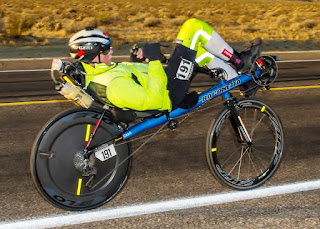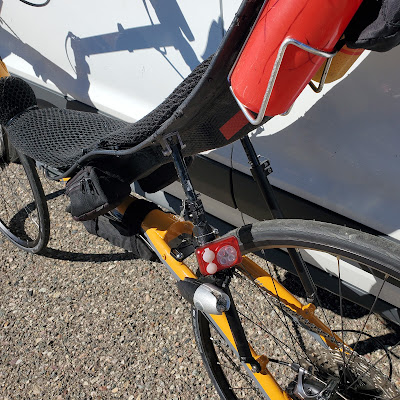In November of 2022, when Kellie Moylan (a very highly regarded athletic performance coach) vaguely brought up the idea that Bill Spaeth and I may want to do the 2023 Silver State 508 ultra race as a relay team … I was nothing less than gob smacked. I’m at the back end of my eighth decade in life.
A year and a half earlier I asked Kellie to `hold me accountable’ as I recovered from rotator cuff surgery and had been told by my doctor to stay off the road if I wanted to bicycle. I was restricted to my indoor `shed’ to do training. Kellie delivered exceptional results, and then some.
I gave nervous consideration to this idea and, a few weeks later, I contacted Bill. He, as well, waited a few weeks before agreeing to do so. He told me that his wife, Sandy Earl, would be our crew chief. That turned out to be a big mistake, as she is no stranger to not finishing (DNF) races. We needed two other crew members. Bill got one and I got the other. We registered with the 508 folks under the name `Raven Lunatics’ in January.
With one grave exception our crew was fantastic, of good cheer, exceptionally competent and focused.
• Bill Spaeth and I were the racers.
• Bill recruited Robert Bertolf to be a crew member.
• I recruited Joe Pixley, a 2015 recumbent finisher of the 508, to be a crew member.
The Silver State 508 is a Race Across America event. Our team attended the required pre-race meeting. Fred Boethling, President of Race Across America, made a solid presentation of the rules of the 508, the expected sportsmanlike behavior of racers and crew, a very touching memoriam to Robert Baldino (an entrant who unexpectedly died just before the race), and an introduction of all the racers.
I’ve spent close to twenty years participating in RAAM sponsored events in roles as racer, race official, crewmember, crew chief and all-around groupie. I’ve learned more about myself from these experiences than from all the bachelor, master’s, and doctoral degrees I’ve accumulated over the years. It has not always been pleasant … neither for me nor for others. Which makes it real, genuine, and profoundly important and meaningful.
Bill and I agreed to do 45 – 75-minute pulls on our bikes in the race. The 508 course is frighteningly challenging. (https://ridewithgps.com/routes/22042364) Two hundred and fifty-four miles east from Reno and two hundred and fifty-four miles back. More than 22,000 feet of climbing into several mountain summits. The road quality is mostly excellent with a few ten or fifteen miles of gnarly chip seal (I thought my bike frame was going to crack). The vehicular traffic, even through the few populated towns on the course, was courteous and, frankly, very encouraging.
Bill rode his Schlitter FreeStyle two wheeled recumbent (700 wheels). I rode my Bacchetta CA3 two wheeled recumbent (650 wheels, triple crank up front with eleven speed 11/42 cassette in back). Our crew follow vehicle was Bill’s Ford Transit van. Three crew. Two racers.
Daytime temperatures were in the high 60’s – low 70’s (Fahrenheit). It was sunny. When we didn’t have a pleasant tailwind, we had minimal crosswind. At night it got down to the mid-20’s (Fahrenheit). We couldn’t really have asked for better weather.
The RAAM race officials rolled past us a few times and there was a mid-course time and aid station along the route.
In my experience this was the most professional and well managed ultra event I have ever experienced. Friendly, attentive, and supportive staff. Clear instructions. Vigilant monitoring. And almost immediate responses when questions arose.
I did not finish the race. I stopped at approximately 193 miles, climbing miles of 5 – 6% grade, around 2:00 AM, 27F. With Bill’s superior performance on some of the mountainous pulls, and my surprising (and slow) climbing after 150 miles, I could not do more. With miles and miles of 6% grades I just didn’t have it.
Bill got out of the van and, with nothing but talent, grit and immense courage, continued on alone for another 69 (or so) miles. I have honestly never witnessed such an athletic and heroic performance. And he didn’t once complain. THAT, in my opinion, is real integrity and sportsmanship.
At that point (after the turnaround from Eureka, NV) it was about 6:00 AM. And the sun was coming up behind us. We all rested for a while before heading back. Coincidentally, the crew stopped in the town of Fallon, Nevada, for breakfast.
We arrived back to Reno around 11:00 AM on Saturday.
-------------------------------------------------------------------
The only negative experience occurred when I notified the crew chief that I simply could not continue climbing. After getting back in the van she made very angry comments and took some dangerous actions that, at the very least, were unsportsmanlike. The last time I saw behavior like that was when I was the Clinical Director of a secure, locked, inpatient psychiatric hospital in Chicago.






























































